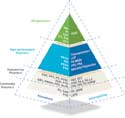Material Selection: The Right Resin for Your Design
MATERIALS
February 1, 2008
|
Material selection affects a number of product-specific characteristics. Therefore, early and accurate resin choices are crucial to successfully launching a product. (Photo by Hubert Schriebl) |
Choosing the right resin for a molding application is a pivotal decision for device manufacturers. And there are several matters that a device designer must consider before finalizing the resin. Material selection is driven by a combination of factors including part design, molding techniques, project requirements, cost targets, and secondary operations. These considerations are overlaid by economic, environmental, and compliance and regulatory issues.
This article discusses the various factors that drive resin selection for medical devices. And the best way to illustrate the principle of resin selection is to look at real devices. Within this article, several medical products are presented to demonstrate both resin and processing choices. Examples include an automated external defibrillator (AED) unit, orthopedic surgical instruments, an orthopedic ankle clamp, a surgical case and tray-delivery system, an ambulance defibrillator unit, and a keyboard-surround application.
The Factors
Let's start with the part itself. Part price is obviously affected by resin cost. But it is also affected by cycle time, required press tonnage, inserts, and secondary operations, all of which are influenced by resin selection.
Resin properties influence part performance. For example, adding filler can increase part stiffness. A gain in one property, however, often coincides with a loss in another. Adding the filler affects tensile elongation. Therefore if both impact and deflection are high on the list of requirements, the application may not pass all necessary specifications. Every resin property required for an application influences material selection in varying degrees.
Beyond part requirements, processing must be considered when selecting a resin. Special processes, like gas assist or structural foam, must be well thought out. The same is true for opportunities that call for more than one resin, as in overmolding applications.
Then there are the factors outside of the list of requirements. A tried-and-true resin that has been used previously for other applications may be more desirable to a designer. A trusted resin supplier that has just introduced a new material might also influence the decision-making process.
And keep in mind that computer modeling, such as CAD and CAE, doesn't drive material selection. All the software programs for part design, mold design, mold filling, and finite element analysis assume the selected resin is sufficient to fulfill all requirements for the application.
Critical Timing. Material selection affects a number of product-specific characteristics. Therefore, early and accurate resin choices are crucial to successfully launching a product. The outcome of a project is a direct result of the engineering approach used at the beginning of product development. An active (front-end) versus reactive (back-end) approach in terms of effort saves time and money on both a short-term and a long-term basis. In studies comparing the effect of both approaches over a complete product development cycle (planning, design, prototyping, and mass production), the reactive approach has been shown to make higher demands of time and money. And perhaps more importantly, the effort differential continues to exist throughout the product's life.
Such higher product costs can affect both the initial launch and later manufacturing. It can cause a delayed launch, resulting in the loss of a strategic time advantage over a competitor. Ultimately, it might mean missing the window of opportunity to be first to market and capturing market share.
First Steps. Vital to a well-substantiated material selection process is the establishment of a complete list of requirements for the product. This list should include a price target, assurance of resin availability for the first choice, and a backup of alternative resins or grades for later cospecification. The list must be generated in the early planning stage and must be as complete as possible. Generating this list is usually the most difficult and underestimated task in a whole project. If even one requirement is not recognized early enough, the whole project could be jeopardized.
|
Figure 1. (click to enlarge) A comparison of amorphous and semicrystalline |
Start by picking the right resin family. The polymer performance pyramid in Figure 1 breaks down some resin options into both amorphous and semicrystalline categories. Amorphous resins have a random polymer structure in both molten and solid phases. Semicrystalline resins are characterized by randomly oriented molecules at molten phase that become densely packed crystalites in solid phase. These structures are formed by small regions of crystalites connected by random polymer molecules.
Figure 1 also shows the performance properties of commodity polymers, engineering polymers, high-performance polymers, and ultrapolymers. Performance characteristics can vary based on the material's properties. Performance might be determined by the material's modulus of elasticity, its heat deflection temperature, its likelihood of exposure to chemicals or UV light, or its behavior in a high-humidity environment. In addition, the material may be exposed to a broad range of operating temperatures and the application still has to work properly. Often, more than one condition has to be achieved. For example, many medical applications have requirements for steam sterilization, chemical resistance, and high-heat resistance (to withstand numerous autoclave cycles).
Numerous factors must be considered when selecting a family of resins. These include but are not limited to the following:
Melt flow, a characteristic for viscosity at low shear rates and flow length.
Fillers (glass and mineral), which significantly affect performance properties.
Surface requirements, like gloss, color, and texture.
Modulus, elongation, and tensile strength for mechanical requirements.
Economic restrictions, including target price, resin availability, colorability, and moldability.
Regulations that the application must comply with, such as Blue Angel, RoHS, FDA, or ISO 10993, to name only a few.
Global compliance requirements on different continents or in different markets (NAFTA, EU, Japan, etc.).
On top of all this, it is important to check for UV exposure, sterilization, radiation, and flammability specifications, which can have significant influence on the number of resin families available for initial selection.
Consider the long-term property requirements for the application based on fatigue, load, and temperature. These aspects are influenced by molecular weight distribution. Often specifications for drop, load, deflection, or cyclic tests must be passed before product launch into the market. A thorough check for chemical exposure may also be necessary under field use conditions or during a repetitive cleaning procedure. Long-term color stability may also need to be tested.
Material Databases and Software
Software tools like material databases (Prospector, MatWeb, Omnexus, Campus, Material Data Center, etc.) can help you select the right material based on the list of requirements. But be prepared, the contents can be overwhelming. For example, MatWeb lists more than 65,000 materials; Prospector, more than 70,000 from more than 600 suppliers. And the numbers change daily. It is nearly impossible to stay current with the databases, because grades are continually added, modified, or deleted.
The most difficult part of using databases is sifting through the data under the constraint of a tight time-to-market requirement.
Another challenge is making one-to-one comparisons among different databases. The material data from the manufacturer dictates the format in which the data are presented. Data can be published according to ISO or ASTM specifications, or even as a result of tests developed and defined by the manufacturer. Most databases contain a mixture of data formats from the above listed specifications that are not necessarily comparable.
CAE tools for finite-element analysis (FEA) and filling simulation can also be helpful. FEA programs include Cosmos, Ansys, and LS-Dyna, among others. For mold filling simulation, Moldflow and Moldex 3D are a couple of options. The benefit of using FEA in terms of resin selection is that it offers the ability to simulate near-real-life scenarios. The process could prevent overengineering from a material perspective. It is often a challenge, however, to gain the necessary input data, such as underload and temperature. The influence of chemicals on a product over time is also difficult to estimate.
Part Design and Process
Part design is driven by many elements, such as wall thickness, size, and complexity, as well as the structural and mechanical requirements. The selected process, either bonding or painting of the parts, and cleaning procedures also play a role in how the part is designed.
Similar to the thigh-bone-is-connected-to-the-hip-bone scenario, wall thickness determines cycle time and part weight; part size affects molding costs and required press tonnage; and rib structures and wall thickness distribution influence part complexity. In turn, the selected process influences many of these variables. Cost targets can be met or missed based on process selection.
There are many processes available to designers today, including:
Injection molding.
Structural foam.
Gas counterpressure.
Gas-assist injection molding (external and internal).
Two-shot molding.
In-mold decorating.
Overmolding.
Insert molding.
High-temperature molding.
Often manufacturers will combine these processes to minimize costs, improve part performance, and add functionality to the device.
Other aspects to consider in material selection include secondary operations and parts consolidation. Is the part converting from metal to plastic? Does the part combine functions through consolidated parts? Can the material selection reduce cycle time, as well as costs for secondary operations? Does the application require brand identification by means of two-color aesthetics? What about noise and vibration dampening or shock absorption? Does the molded part need painting, powder coating, or metallizing? If so, adhesion will be critical.
Material and process selection should be based on the parts lists of requirements.
Conclusion
Successful material selection is based on early consideration of the application's requirements. As needed, CAE tools, FEA, and mold-filling simulation software will help to solidify a design and the associated resin selection. A defined cost target is critical to protect against developing an application out of its prescribed cost range.
The importance of choosing both the right molding technique and the right resin cannot be emphasized enough. An inappropriate combination of the two will ultimately result in higher-than-expected costs, a more difficult-to-manufacture product, or a product that doesn't meet all the objectives.
Ultimately, material selection must occur at the start of a project in order to proceed with the product development schedule realistically. If that can't happen, for whatever reason, develop a backup material option in case certain requirements are at risk of not being met or all requirements are not yet defined. Clearly this is a risky path, and such a reactive engineering approach is definitely not the recommended route. To save both time and money, remember that when to choose is as important as what to choose.
Michael Hansen is senior technical development engineer for Mack Molding Co. (Arlington, VT). He can be contacted at [email protected].
Copyright ©2008 Medical Device & Diagnostic Industry
About the Author(s)
You May Also Like




